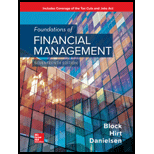
EBK FOUNDATIONS OF FINANCIAL MANAGEMENT
17th Edition
ISBN: 9781260464900
Author: BLOCK
Publisher: MCGRAW-HILL LEARNING SOLN.(CC)
expand_more
expand_more
format_list_bulleted
Question
Chapter 18, Problem 15P
Summary Introduction
To explain:The plan that will maximize the market value of the stocks of Vinson Corporation.
Introduction:
Dividend Policy:
The policy used by a company to form a structure for the disbursement of dividend to its shareholders in terms of amount and frequency is termed as the dividend policy.
Expert Solution & Answer
Want to see the full answer?
Check out a sample textbook solution
Students have asked these similar questions
Choose correct solution pl
Company A problem.
no ai
Question three solve
Chapter 18 Solutions
EBK FOUNDATIONS OF FINANCIAL MANAGEMENT
Ch. 18 - Prob. 1DQCh. 18 - Prob. 2DQCh. 18 - Prob. 3DQCh. 18 - Prob. 4DQCh. 18 - Prob. 5DQCh. 18 - Prob. 6DQCh. 18 - Prob. 7DQCh. 18 - Prob. 8DQCh. 18 - Prob. 9DQCh. 18 - Prob. 10DQ
Ch. 18 - Prob. 11DQCh. 18 - Prob. 1PCh. 18 - Prob. 2PCh. 18 - Prob. 3PCh. 18 - Prob. 4PCh. 18 - Prob. 5PCh. 18 - Planetary Travel Co. has $240,000,000 in...Ch. 18 - Prob. 7PCh. 18 - Prob. 8PCh. 18 - In doing a five-year analysis of future dividends,...Ch. 18 - Prob. 10PCh. 18 - The shares of the Dyer Drilling Co. sell for $60 ....Ch. 18 - Prob. 12PCh. 18 - Prob. 13PCh. 18 - Phillips Rock and Mud is trying to determine the...Ch. 18 - Prob. 15PCh. 18 - Prob. 16PCh. 18 - Prob. 17PCh. 18 - Prob. 18PCh. 18 - Prob. 19PCh. 18 - Prob. 20PCh. 18 - Prob. 21PCh. 18 - Prob. 22PCh. 18 - Prob. 3WE
Knowledge Booster
Learn more about
Need a deep-dive on the concept behind this application? Look no further. Learn more about this topic, finance and related others by exploring similar questions and additional content below.Similar questions
- Solve this finance question.arrow_forwardCalculate emi solarrow_forwardAccording to car experts, which of the following ordinarily provides the best value in automobile ownership? Always buying a new car and driving it only a few years. Buying a relatively new used car and driving it for a long time. Buying the cheapest used car available.arrow_forward
- Pat and Chris have identical interest-bearing bank accounts that pay them $15 interest per year. Pat leaves the $15 in the account each year, while Chris takes the $15 home to a jar and never spends any of it. After five years, who has more money? Explarrow_forwardSolve this finance with no aiarrow_forwardExplain about corporate finance? no aiarrow_forward
- Solve it Pat and Chris have identical interest-bearing bank accounts that pay them $15 interest per year. Pat leaves the $15 in the account each year, while Chris takes the $15 home to a jar and never spends any of it. After five years, who has more money?arrow_forwardFinance question subject. solvearrow_forwardNo ai answerarrow_forward
arrow_back_ios
SEE MORE QUESTIONS
arrow_forward_ios
Recommended textbooks for you

 EBK CONTEMPORARY FINANCIAL MANAGEMENTFinanceISBN:9781337514835Author:MOYERPublisher:CENGAGE LEARNING - CONSIGNMENT
EBK CONTEMPORARY FINANCIAL MANAGEMENTFinanceISBN:9781337514835Author:MOYERPublisher:CENGAGE LEARNING - CONSIGNMENT Intermediate Financial Management (MindTap Course...FinanceISBN:9781337395083Author:Eugene F. Brigham, Phillip R. DavesPublisher:Cengage Learning
Intermediate Financial Management (MindTap Course...FinanceISBN:9781337395083Author:Eugene F. Brigham, Phillip R. DavesPublisher:Cengage Learning


EBK CONTEMPORARY FINANCIAL MANAGEMENT
Finance
ISBN:9781337514835
Author:MOYER
Publisher:CENGAGE LEARNING - CONSIGNMENT

Intermediate Financial Management (MindTap Course...
Finance
ISBN:9781337395083
Author:Eugene F. Brigham, Phillip R. Daves
Publisher:Cengage Learning
FIN 300 Lab 1 (Ryerson)- The most Important decision a Financial Manager makes (Managerial Finance); Author: AllThingsMathematics;https://www.youtube.com/watch?v=MGPGMWofQp8;License: Standard YouTube License, CC-BY
Working Capital Management Policy; Author: DevTech Finance;https://www.youtube.com/watch?v=yj-XbIabmFE;License: Standard Youtube Licence